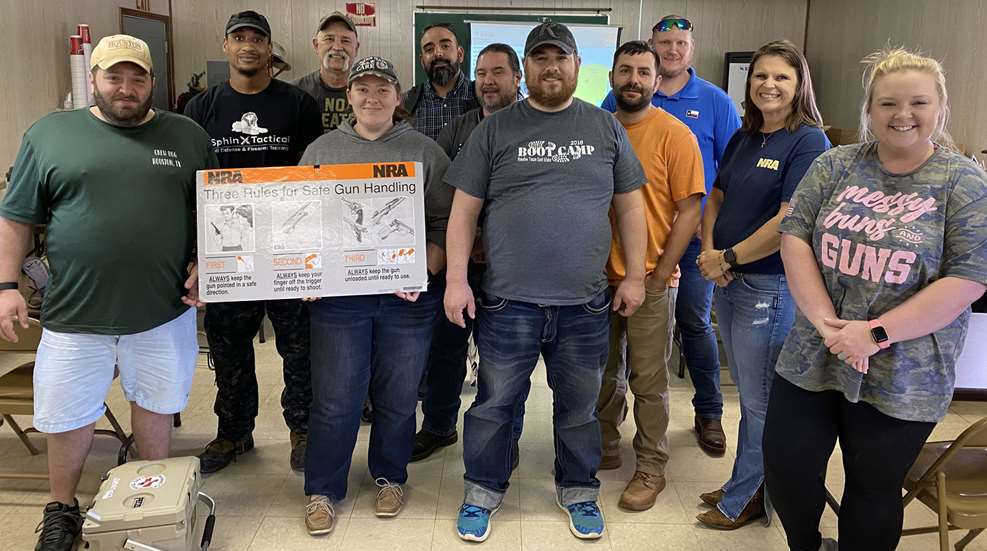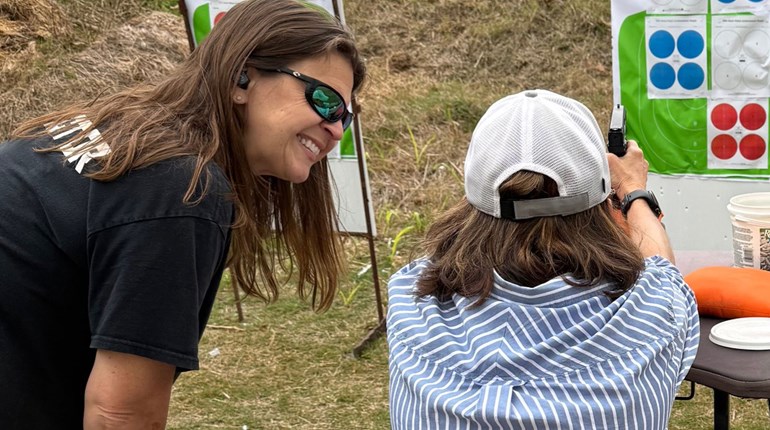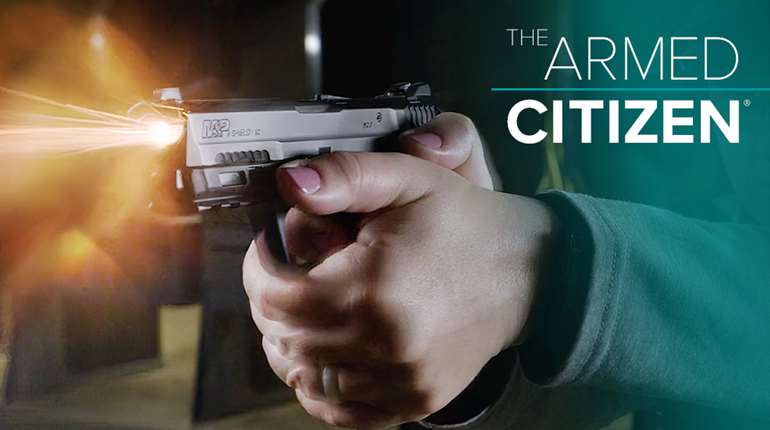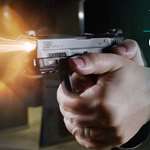
More and more people are exploring their options to purchase a firearm for the very first time—and many of them did not grow up in a household with firearms. As adults, they have either married into firearms, have a circle of friends who are firearm enthusiasts, or they have kids who are expressing an interest to learn about guns and a desire to enter the shooting sports.
New gun owners are usually seeking hands-on educational training opportunities to help guide them along their journey. They are also looking for a quality class taught by a reputable instructor. An NRA Certified Firearm Instructor is the “gold standard,” and Certified Instructors can provide a basic class to teach the knowledge, skills and attitude (KSAs) necessary to own and operate a firearm safely.
As an NRA Certified Firearm Instructor, how you plan your firearm training class will set the tone for a successful experience, not only for you but for all students in attendance. Offer an experience that is welcoming to all who attend. To do this, consider where you will teach, how you will welcome your attendees, understand the different learning styles, and have effective communication before, during and after your class.

Location
If you are offering firearm training that includes both classroom and range time, find a suitable location, ideally where you can do both class and range instruction at the same facility or on the same property, or at a minimum, in close proximity to each other. Ensure your facility is easy to find and easy to access. Type in the facility’s address in a search engine or on a map application to see if the directions are accurate and take the student directly to your location. Be mindful that new shooters may be apprehensive or fearful of taking this first step into the world of firearms. Gun stores and shooting ranges may be intimidating and overwhelming to a first timer. If your classroom is situated in the same building as an indoor range, learning may be difficult if your students have not heard the sounds associated with indoor target shooting. Consider having a nearby location suitable for a classroom environment, if necessary.
Ensure there is adequate parking available. Invest in signage to direct your students to the parking area as well as signs directing them to your classroom, if located inside another building. Greeting your students at the door to welcome them to class is always beneficial to show them you are glad they came! These few simple actions can ease their anxiety and make them feel more comfortable entering unfamiliar territory.
Welcome
Always show up at least an hour early to ensure everything is ready for your class. I show up two hours before class time. Even though I have my teaching preparation routine down to a science, it still takes some time to tidy up my classroom, sweep, clean the bathroom, wipe down the tables, unload my truck, set up my teaching area, connect my laptop and projector, open my presentation, arrange my snacks and donuts table, set out bottled water, and turn on my coffee pot to brew fresh coffee. I also have a sign-in table with classroom and range releases, waivers, and an emergency contact form for them to fill out. I print my class roster so my attendees can verify their information is accurate. From the roster, I make each student a name tent ahead of time using colored paper and writing their name in big bold letters.
As students arrive, greet them at the door with an introduction, handshake and a smile, and invite them into the classroom to find a seat and help themselves to snacks and coffee. Direct them to the sign-in table for paperwork and to pick up their name tent. As more students arrive, introduce them to each other as they gather, so they feel comfortable surrounded by like-minded people they will be spending the day, or multiple days with. When class begins, go around the room and have everyone say who they are, where they come from, why they are here, and what their experience with firearms is. Learning the names and backgrounds of your students builds trust and enhances the learning environment. Calling a student by name makes them feel welcomed, part of the group, and invested in the experience.
Learning Styles
Everyone learns and retains information differently. According to Edgar Dale, who developed the “Cone of Experience,” we remember 10 percent of what we read, 20 percent of what we hear, 30 percent of what we see, 50 percent of what we see and hear, 70 percent of what we discuss with others, 80 percent of what we personally experience, and 95 percent of what we teach others. For this reason, it is beneficial to team teach with other instructors who have different backgrounds and perspectives for participants to connect with and learn from. I frequently team teach with my husband. He can explain a topic to a student, and they may have a hard time understanding the concept. I can jump in and say the exact same thing in a slightly different way, and the student may completely understand what I am saying. Different learning styles; different teaching styles.

Always encourage participants to ask many questions, no matter how obvious the answer may be. If they are asking, there are probably others in class who are thinking the same thing. Having a relaxed, comfortable, supportive, and encouraging classroom environment will only make the participants feel more comfortable with the topic and as a result, they will become a more knowledgeable firearm enthusiast.
Communication
Effective communication begins long before your firearms training class happens. It is quite simple to schedule your NRA Basic Firearm class on your NRAInstructors.org Dashboard. If you advertise it as a public class, you will be notified via email when someone signs up. Frequently visit your Instructor Dashboard and check the class roster to see if those enrolled students have added comments or asked questions upon their registration. Make it a habit to reply to your new students as soon as you can to acknowledge their registration. Approximately one week prior to class time, I send everyone who is registered a second email. To ensure I capture all the important information, I created a document that I simply copy and paste into an email. This personalized email thanks the students for registering and provides driving directions, course outline and times, available amenities, necessary items to bring, what items are provided, and as many details as possible so they are prepared for the upcoming class and know what to expect.
On the day of your class, keep your phone handy in case a student calls, texts or emails with last-minute questions, concerns, or is lost and needs help navigating. Another benefit of arriving early to your classroom and having all your materials set up ahead of time so you are available to step outside to direct students to park and locate your classroom. You only get one chance to make a first impression, so take this opportunity to introduce yourself at the beginning of class and set expectations high from the start, so students know where they are headed and how they are going to get there. Provide participants with a mix of hands-on and classroom learning opportunities to enhance skills, since we know that everyone has a different style of learning. Create online and hard copy resources that participants can refer to after the event for continued learning. Always encourage questions and stimulate discussion so all attendees feel engaged and invested in course content.
When the class is over, always send each student off with another handshake and thank you for coming. Later that evening, always send a follow-up email. This is another document I already have prepared and can copy and paste into a message to everyone. Included in my communication are additional resources for continued opportunities, answers to questions that may have arisen during class time, and upcoming events they may be interested in taking advantage of.
For those of us who have been around firearms for many years or longer, we often forget what it was like being a first timer. There are many questions and concerns that arise through the eyes of a new gun owner. It is praiseworthy if they seek knowledge and proper information by finding a basic firearm course offered by a certified NRA Instructor. A new firearm enthusiast will continue the journey if they have a positive first experience among other likeminded individuals. NRA Firearm Instructors can enhance their journey by welcoming these new people, incorporating a variety teaching methods to match learning styles and effectively communicating with them. Follow-up is the last step in our shooting fundamentals and is equally important to effectively communicate and encourage growth with all of the new students we come in contact with.














































